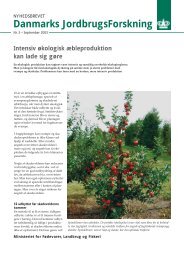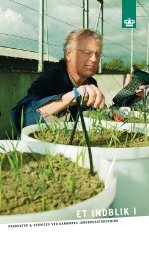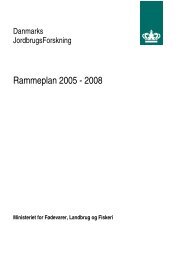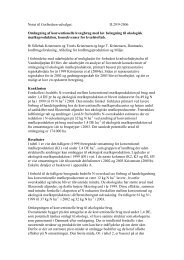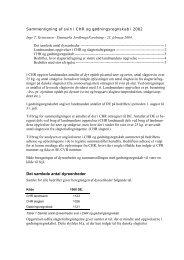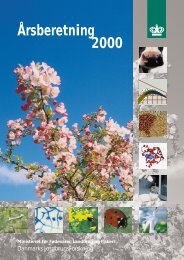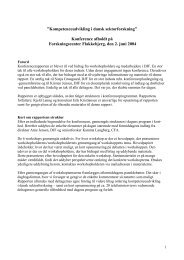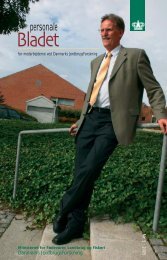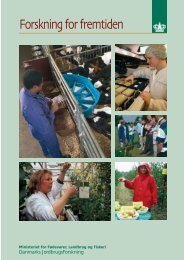Reproduction performances and conditions of group-housed non ...
Reproduction performances and conditions of group-housed non ...
Reproduction performances and conditions of group-housed non ...
Create successful ePaper yourself
Turn your PDF publications into a flip-book with our unique Google optimized e-Paper software.
- Paper I -<br />
1. Introduction<br />
The number <strong>of</strong> <strong>group</strong> <strong>housed</strong> <strong>non</strong>-lactating sows is increasing rapidly in Europe as a consequence<br />
<strong>of</strong> changed legislation initiated by elevated public concern <strong>of</strong> animal welfare. According<br />
to EU legislation from January 2013, all sows have to be loose-<strong>housed</strong> in smaller or<br />
larger <strong>group</strong>s from four weeks after mating until seven days before expected farrowing<br />
(Council Directive 2001/88/EC amending Directive 91/630/EEC Laying Down Minimum<br />
St<strong>and</strong>ards for the Protection <strong>of</strong> Pigs). In United Kingdom, all sows have to be <strong>group</strong> <strong>housed</strong><br />
in the entire period from weaning to seven days before expected farrowing according to the<br />
national legislation (Mortensen, 1997). In Norway, the sows may only be fixed from three<br />
days before until one week after farrowing <strong>and</strong> in Sweden, it is only allowed to keep sows<br />
in crates for maximal one week if necessary during the production cyclus (Baustad & Lium,<br />
2002). Similar tendencies are seen in other parts <strong>of</strong> the world (Trezona, 2003).<br />
Impaired reproduction in form <strong>of</strong> reduced litter size <strong>and</strong> pregnancy rate in <strong>group</strong> <strong>housed</strong><br />
sows compared to individual <strong>housed</strong> sows in parts <strong>of</strong> or in the entire <strong>non</strong>-lactating period<br />
has been observed in several on-farm studies. The impairment has been in the range <strong>of</strong> 0.3<br />
(Hansen, 2000) to 0.6 (Fisker, 1995) less born piglets per litter, 0.9 %-point lower farrowing<br />
rate (Hurtgen et al., 1980) <strong>and</strong> 3.4 %-point higher repeat breeding rate in autumn<br />
(Peltoniemi et al., 1999). However, in other studies, no difference (Gjein & Larssen, 1995;<br />
Hansen, 2003) or even opposite effects have been found (Bates et al., 2003; Hansen, 2003).<br />
The divergent results are probably a result <strong>of</strong> differences in the function <strong>of</strong> the <strong>group</strong> housing<br />
systems.<br />
Systems with <strong>group</strong> <strong>housed</strong> <strong>non</strong>-lactating sows can vary in a number <strong>of</strong> ways, e.g. in <strong>group</strong><br />
size, <strong>group</strong> dynamics, floor type <strong>and</strong> feeding system. A commonly used feeding procedure<br />
is <strong>group</strong> feeding, providing the feed on the floor or in long feeding trough. These feeding<br />
procedures are economical attractive because <strong>of</strong> the low investments costs, however, the<br />
disadvantage is that individual rationing is not possible. A more expensive alternative to<br />
<strong>group</strong> feeding is individual feeding. Examples <strong>of</strong> popular individual feeding procedures are<br />
the Electronic Sow Feeding (ESF) system, where sows are fed automatically in a crate, one<br />
at a time (Brouns & Edwards, 1992), <strong>and</strong> one feeding stall per sow, where all sows are fed<br />
at the same time in individual crates that closes during eating (Nielsen et al., 1997).<br />
In systems with <strong>group</strong> feeding, the individual sow is not protected during feeding from displacements<br />
by other sows <strong>and</strong> studies have indicated lower feed intake in low ranking sows<br />
compared to high ranking sows in form <strong>of</strong> lower weight gain (Brouns & Edwards, 1994;<br />
Ruis et al., 2002), less increase in chest girth (Olsson & Svendsen, 1997), less time spent at<br />
the central area <strong>of</strong> a pile <strong>of</strong> feed provided on the floor (Csermely & Wood-Gush, 1990) <strong>and</strong><br />
23




